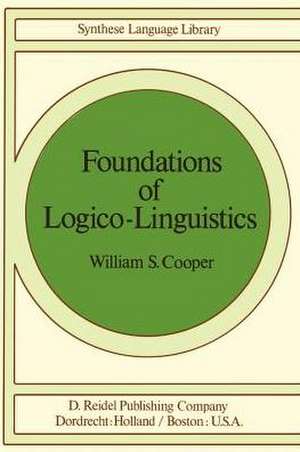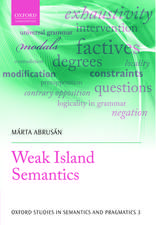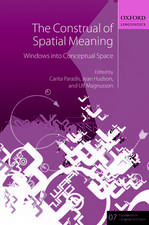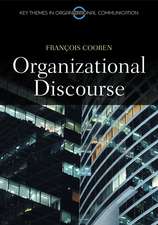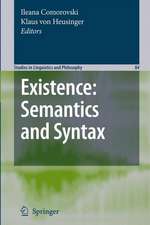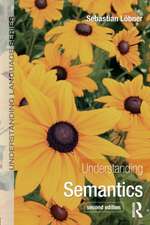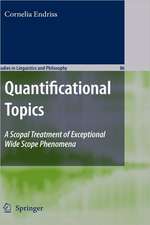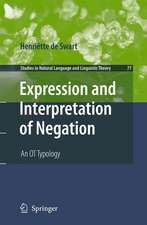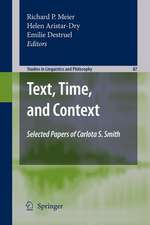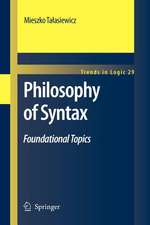Foundations of Logico-Linguistics: A Unified Theory of Information, Language, and Logic: Studies in Linguistics and Philosophy, cartea 2
Autor W.S. Cooperen Limba Engleză Paperback – 30 apr 1978
Din seria Studies in Linguistics and Philosophy
- 15%
 Preț: 583.78 lei
Preț: 583.78 lei - 18%
 Preț: 728.43 lei
Preț: 728.43 lei - 20%
 Preț: 1918.99 lei
Preț: 1918.99 lei -
 Preț: 393.35 lei
Preț: 393.35 lei - 18%
 Preț: 1219.29 lei
Preț: 1219.29 lei - 18%
 Preț: 733.78 lei
Preț: 733.78 lei - 20%
 Preț: 563.41 lei
Preț: 563.41 lei - 20%
 Preț: 509.80 lei
Preț: 509.80 lei - 15%
 Preț: 645.28 lei
Preț: 645.28 lei - 18%
 Preț: 723.69 lei
Preț: 723.69 lei - 18%
 Preț: 1552.05 lei
Preț: 1552.05 lei - 18%
 Preț: 953.65 lei
Preț: 953.65 lei - 15%
 Preț: 647.27 lei
Preț: 647.27 lei - 18%
 Preț: 959.98 lei
Preț: 959.98 lei - 18%
 Preț: 1832.39 lei
Preț: 1832.39 lei - 15%
 Preț: 646.30 lei
Preț: 646.30 lei - 18%
 Preț: 953.03 lei
Preț: 953.03 lei - 18%
 Preț: 1224.06 lei
Preț: 1224.06 lei - 18%
 Preț: 952.09 lei
Preț: 952.09 lei - 18%
 Preț: 942.01 lei
Preț: 942.01 lei - 18%
 Preț: 947.50 lei
Preț: 947.50 lei - 18%
 Preț: 955.70 lei
Preț: 955.70 lei - 18%
 Preț: 1223.43 lei
Preț: 1223.43 lei - 15%
 Preț: 653.00 lei
Preț: 653.00 lei - 15%
 Preț: 645.28 lei
Preț: 645.28 lei -
 Preț: 391.99 lei
Preț: 391.99 lei - 18%
 Preț: 942.01 lei
Preț: 942.01 lei
Preț: 394.71 lei
Nou
Puncte Express: 592
Preț estimativ în valută:
75.55€ • 82.09$ • 63.50£
75.55€ • 82.09$ • 63.50£
Carte tipărită la comandă
Livrare economică 21 aprilie-05 mai
Preluare comenzi: 021 569.72.76
Specificații
ISBN-13: 9789027708762
ISBN-10: 9027708762
Pagini: 268
Ilustrații: XVI, 250 p. 2 illus.
Dimensiuni: 155 x 235 x 14 mm
Greutate: 0.57 kg
Ediția:Softcover reprint of the original 1st ed. 1978
Editura: SPRINGER NETHERLANDS
Colecția Springer
Seria Studies in Linguistics and Philosophy
Locul publicării:Dordrecht, Netherlands
ISBN-10: 9027708762
Pagini: 268
Ilustrații: XVI, 250 p. 2 illus.
Dimensiuni: 155 x 235 x 14 mm
Greutate: 0.57 kg
Ediția:Softcover reprint of the original 1st ed. 1978
Editura: SPRINGER NETHERLANDS
Colecția Springer
Seria Studies in Linguistics and Philosophy
Locul publicării:Dordrecht, Netherlands
Public țintă
ResearchCuprins
1. Introduction.- 1.1 Aims.- 1.2 Beyond Syntax.- 1.3 Bloomfield’s Dilemma.- 1.4 The Research Strategy of the Isolable Subsystem.- 1.5 Theories of Language vs. Language Analysis.- 1.6 Theories of Logic.- 1.7 Logico-Linguistics.- 2. Information and Language.- 2.1 Information States.- 2.2 Input and Output.- 2.3 Information Automata.- 2.4 Language Automata.- 2.5 Black-Box Methodology.- 2.6 The What-Do-You-Know? Game.- 2.7 The Behavior-Analytic Interpretation of Language Automata.- 2.8 The Linguistic Priority of the Language Automaton.- 2.9 Languages.- 2.10 Summary.- 3. On Describing Languages.- 3.1 Descriptive Strategies.- 3.2 Descriptive Equivalence.- 3.3 Language Descriptions as Scientific Theories.- 3.4 Basic Evidence Propeties.- 3.5 The Evidence-Gathering Process.- 4. Language and Deductive Logic.- 4.1 Idealizations.- 4.2 Logical Relationships.- 4.3 Properties of the Logical Relationships.- 4.4 Logics.- 4.5 Informative Languages have Incomplete Logics.- 4.6 Quasi-logical Relationships.- 4.7 Quasi-logical Relationships are often Logical.- 4.8 Logic in the Evidence-Gathering Process.- 5. Semantics, Axiomatics.- 5.1 Semantically Structuralizable Languages.- 5.2 Examples of Artifical Semantically Structuralizable Languages.- 5.3 A Fragment of English.- 5.4 Semantics and Deductive Logic.- 5.5 Axiomatic Language Descriptions.- 5.6 Other Language Families.- 5.7 Logic as a Branch of Linguistics.- 5.8 Syntax, Semantics, Pragmatics.- 6. Meaning.- 6.1 Purports and Imports.- 6.2 Purport-Import Glossaries.- 6.3 Specialized Glossaries.- 6.4 Synonymy.- 7. Language and Inductive Logic.- 7.1 Credibility Weights.- 7.2 Probability Weights.- 7.3 Deductive Logic in Probability-Weighted Languages.- 7.4 The Semantics of Probability-Weighted Languages.- 7.5 Plausible Inference.- 7.6Statistical Inference.- 7.7 Inductive Reasoning.- 7.8 Extended Semantics.- 8. ‘If-Then’: A Case Study in Logico-Linguistic Analysis.- 8.1 Preliminary Statement of Hypotheses to be Tested.- 82 History of Hypothesis A.- 8.3 History of Hypothesis B.- 8.4 History of Other Hypotheses.- 8.5 Delineation of Constructions of Interest.- 8.6 The Working Hypothesis of Extended Semantic Structuralizability.- 8.7 Exact Statement of Hypothesis A.- 8.8 Exact Statement of Hypothesis B.- 8.9 Remarks on Hypothesis B.- 8.10 Contraposition.- 8.11 Methodological Review.- 8.12 The Hypothetical Syllogism.- 8.13 Further Inference Patterns.- 8.14 The Paradoxes of Material Implication.- 8.15 The Second Paradox Re-examined Dynamically.- 8.16 Modus Ponens and Modus Tollens.- 8.17 Order of Premises.- 8.18 Incompatible Conditionals.- 8.19 Self-Contradictory Conditionals.- 8.20 Aristole’s Slip.- 8.21 Incompleteness of the Rules Governing Conditionals.- 8.22 Logically Disjunct Conditionals.- 8.23 Negations of Conditionals.- 8.24 Conjunctions of Conditionals.- 8.25 Conditionals Containing Other Conditionals.- 8.26 Lewis Carroll’s Barbershop Paradox.- 8.27 Disjunctions of Conditionals.- 8.28 Conclusions about If—then.- 8.29 Further Case Studies.- 8.30 Concluding Remark.- 9. Problem Areas and Computer Applications.- 9.1 Choice of Linguistic Unit.- 9.2 Ambiguity.- 9.3 Context-Dependence.- 9.4 Linguistic Incompleteness.- 9.5 Non-declarative Sentences.- 9.6 Physical Realizability.- 9.7 Automatic Question-Answering.- 9.8 Enthymemes, Analyticity.- 9.9 Further Computer Applications.- 9.10 Artificial Intelligence.- 9.11 The Future.- References.
